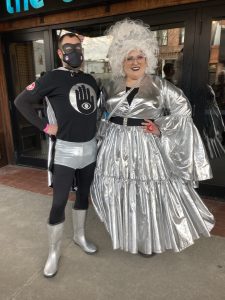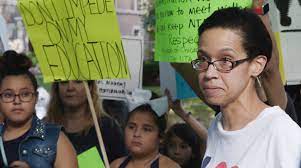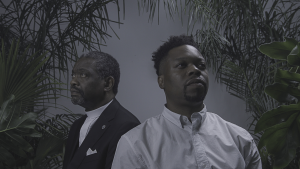
At True False Film Fest, volunteers dress in fantasy garb to greet the moviegoers.
True False Film Fest, nestled into the college town of Columbia, MO, isn’t just a film festival. It’s a warmblooded celebration of creativity of all kinds, and also a sprawling community event that includes musical performances, visual art exhibitions, and a parade. People take vacation time to make this an annual destination, and they come from the West Coast, Maine, and right in town. They come to the films to learn, expand their horizons, and discuss them at length with their neighbors in line and in the coffee shops and bars.
Three of the four curators are new, and they have carried into the new era the spirit of inquiry, the stubborn noncommerciality, the prizing of authorial cinema of the former era. Chloé Trayner, the new director, said that keeping the core values of playfulness and inclusivity were central to the new team’s goals. They expanded the “filmmaker-forward side of things” to the community, providing more ways to interact with the filmmakers. They brought in “more international voices, to open up what a True False film looks like.”
Let the Little Light Shine
Two of my favorite films in the festival were world premieres. Let the Little Light Shine, directed by Kevin Shaw and produced by Rachel Dickson, is an extraordinary film about a movement of Black parents in Chicago to protect their top-ranked, mostly-Black elementary school from gentrification and racism. Chicago Public Schools attempted over years to turn the school into a high school, to favor white gentrifiers who didn’t want to send their kids to their own local high school (too Black). The film follows the organizers, including parent leader Elisabeth Greer, principal Isaac Castelaz, and students, into their own strategy meetings, CPS and city council meetings, and protests. Inside the school, it shows intimately how teachers and administrators enable and support student learning, and how the students rise to the challenge of organizing. The film builds toward a final facedown and a tense finale.
By showing the process, the film captures devastatingly revealing moments that show how endemic and systemic racism works out in daily life. A white professional parent simply denies that racial animus exists; for him, it’s about class. Greer describes to the camera, with tears in her eyes, how much it hurts to realize that her opponents simply have no space inside their heads for the possibility of an all-Black classroom to be excellent. “We can’t be smart,” she says, of their world-view. At a community meeting, we hear white people use terms like “gang-infested” and other slurs to describe the Black community schools they refuse to send their children to, and “decent, hard-working” to describe themselves. Then we watch a woman use her time to explain what racist dog whistles sound like in this very meeting.
Racism is about the hottest, most dangerous topic in America today; it threatens to destroy our best hopes, and confronting it is also the biggest threat to the status quo. This is a story that

Parent activist Elisabeth Greer mobilizes protesters, in “Let the Little Light Shine.”
describes the struggle for racial justice as a fundamentally American and democratic story. It’s about public education, why everybody deserves a good one, and how hard it is to stop the system from reinforcing the oldest inequities. This film was incubated at Kartemquin Films’ Diverse Voices in Documentary program, and Rachel Dickson is a Kartemquin Associate. Kartemquin Films is long noted for close-up looks at the processes that inform the conflicts of American democracy—racial, class, gender. This is an extraordinary contribution to that body of work. Made in part with taxpayer funding through the Independent Television Service (ITVS), it will be shown on public broadcasting’s POV on December 12, where it’ll be accessible (if stations don’t pre-empt it) to 98% of the American people.
I hope there’s a vigorous engagement campaign, because I saw what happened at True False. People were breathing along with the film from the start. They were clapping, crying, cheering, and gasping. There were four standing ovations in the session I was in. This was a community engagement session attended by T/F partners. One woman stood up and said, “This isn’t just going on in Chicago. The same thing is happening right here in Columbia, and we need to own it!” Another yelled out, “Why isn’t this school a model not just for Chicago but for the whole country?” People were on fire.
After Sherman
Another extraordinary world premiere, in a completely different mode, was Jon-Sesrie Goff’s After Sherman. Sometimes an essay, sometimes a poem, sometimes a meditation, sometimes a denunciation and sometimes a celebration, the film sketches out the problem: Black people in America have systematically been stripped of memory and roots. Then it gradually fills in a portrait of how Black people create home, memory and place in spite of it. This portrait is then ruptured violently by the shooting of nine churchgoers in Charleston, S.C., at an event that Goff’s father and mother had just left.
The film is carefully chaptered, with elegant animation. The film opens by naming many indigenous groups that the Gullah area of South Carolina once sustained. As the camera swoops through swamps and along creeks, the theme of “home” emerges. These coastal southern territories are a metaphorical home for the dispossessed, a memory for those ripped from their heritage, a monument to Black creativity and resilience. The film then moves into the history of enslavement in the area, and the great betrayal of the government and corporations after Sherman pledged to 20 Black leaders that formerly enslaved people would get protected land. Today’s descendants speak sharply to the dispossessors of the past, represented in archival documents and current monuments. We are then introduced to the tensions around the concept of “home” as Blacks continue the diaspora, in search of a a place where they can escape the pervasive racism of America. One speaker recalls Malcolm X’s comment, “The South is anywhere below the Canadian border.” And then, the unspeakable: the Charleston shooting, both a national atrocity and a terrifyingly personal moment. Goff’s father personally coordinated the nine funerals. Finally, the film returns to the question of land ownership, and turns toward the future.
The long buildup to this moment puts the long betrayal and the equally long resistance and creative re-imagining of home, memory and community in context. The Charleston murders were the latest lynching, massacre, erasure; After Sherman is a response that echoes the response of generations, about love, joy, family, community, and place, even when it is imagined.
Formally, the film is so daringly experimental that it took my breath away. It’s a shocking piece of art; it reminded me of what it felt like to first watch Isaac Julien’s early work (although the film looks nothing like that). There is much layering, and deliberate disjuncture; audio remarks don’t match the visuals, or they do in a way that puts them into italics or even ALL CAPS. These experiences of displacement and of layered experiences evoke the fractured experience of memory and home in Black experience. Archival footage is worked and played with, reminding you of its degraded VHS origins, or its home-movieness, or its nostalgia-drenched meaning. Soundtrack evokes memory with a twist, as harmonies move into dissonance, or a different era’s sound into ours.

Filmmaker Jon-Sesrie Goff (right) and his father, in “After Sherman.” Courtesy Arshley Emile.
The rich tradition of Black experimental film profoundly influenced the film, Goff told me in interview. If the opening sequences of Gullah land remind you of Julie Dash’s Daughters of the Dust, it should. The walls of family photos, perused meditatively, evoke the work of Thomas Allen Harris. The sound layering, and use of chorale? Look to the late, great Marlon Riggs. The arch posing of the Goffs father and son, surrounded by carefully placed ferns? Recall Camille Billops’ Suzanne, Suzanne. And the introduction of the filmmaker himself into the story? His approach, with his back to the viewer, is an homage to the work of John Akomfrah. In fact, his awareness that he stood on the shoulders of so many artists, all using their creativity and craft to share Black realities, became a problem, he said. He finally had to strip out some of his homages, in order to make room for his own voice. I’m looking forward to Goff’s second film, because the voice we encounter in After Sherman is worth hearing a lot more from.
The film took years to take its shape, for many reasons, the film team explained in the screening Q&A. It was well along when the Charleston murders happened. Afterward, others pitched the format of true crime. The film’s producer, Blair Doroshwalther, told Jon-Sesrie and Madeline Goff why that would never work: “None of those people are part of the community, and the community is your focus. The biggest violence in the film isn’t that moment of violence but the small daily acts of violence that happen all the time in that place.” Goff followed up: “The original taking of the land, that was the biggest violence.” That insight kept them oriented to the end, which is still in sight—the film’s soundtrack was still temp for the premiere.
This film too will be on POV, and it was also made in part with taxpayer money, via ITVS. Goff told me that one commercial outlet’s rep told him, after seeing it, “Thank God for public broadcasting, because this would never get on commercial TV.” Goff agrees. There needs to be space, not only for creative work at the cutting edge, but also for crucially important topics for American democracy, topics routinely avoided in other venues. Let the Little Light Shine and After Sherman are shining examples of that. So, by the way, is the interactive installation (and also web interactive) Un(re)solved, about some of the people whose murder cases were reopened as a result of the 2007 Emmett Till Unsolved Civil Rights Crime Act. Un(re)solved, by Tamara Shogaolu, is a project of the public TV series Frontline.
Ethics of filmmaking
The vigorous discussion in the field about best practices in ethical documentary filmmaking, ranging from non-extractive storytelling to appropriate use of technology to crediting and collaboration, was reflected at the festival. At the Based on a True Story (BOATS) conference, held at the Reynolds Journalism Institute at University of Missouri, my colleague Marissa Woods and I had the privilege of showcasing our recent report on accountability in documentary. On that panel, Kevin Shaw talked about prioritizing community in his filmmaking practice, working closely throughout with the film’s participants. He learned much about this, he said, from Gordon Quinn (founder of Kartemquin Films), who has long spoken out about the need for participant-centered documentary ethics. Abby Sun, a media historian, addressed the failures of the journalism ecology, from quick-hit reports drawn from press releases to a lack of knowledge about the economic interests behind the choices documentary filmmakers may make. Critic Kristal Sotomayor described their acute awareness of how film criticism by white cisgender men often betrays the blinders of privilege.
Films themselves also evoked ethical issues, and attention to them. The nature of collaboration with participants was on display. Srdjan Kovacevic, director of the fascinating Factory to the Workers, about a Croatian worker-owned and -run factory, agreed in advance to division of any profits between the participants in the film and the filmmakers. In making The Territory, Alex Pritz co-produced it with the Uru-ue-wau-wau Amazonian Indians. They also learned how to make video, and not only filmed themselves but took on contracts for more media work. (They went to COPP26 as reporters.) It tells the struggle of the people—all 180 of them—to protect their legally recognized territory and the rainforest.

True False filmgoers have many opinions, and share them while waiting in line for packed sessions.
Aliona Van der Horst’s Turn Your Body to the Sun, a moving and personal retelling of the brutal treatment of WWII Soviet POWs—especially once they returned home to be put in gulags, featured creative colorization and foleying of government footage. In this case, it was elegantly executed to render the manipulation visible, while still effective for its function of evoking memory. It was also a reminder of the technical sophistication that can be applied to documentary form, for good and for ill.
What about taking care not to retraumatize your participants? At BOATS, Robert Greene, whose films regularly employ re-enactment and dramatizing, said he had become convinced in his recent work Procession, featuring men abused by Catholic priests in childhood, that therapists were essential on set in the future. But Eliane Raheb’s Miguel’s War, an aimless portrait of a troubled 50-year-old gay man who seems to have more issues with his mom than with the Lebanese civil war that he was thrust into as a teenager, Raheb appears to have cheerfully taken on the role of amateur therapist while also exploring her own issues with her mom, with no professional help in sight.
The question of voice and authenticity inevitably came up. In discussing collaboration, Keith Wilson, producer of I Didn’t See You There, and editor Todd Chandler talked about working with director Reid Davenport. The director is physically disabled because of cerebral palsy; the movie (it won the best doc directing award at Sundance) lets viewers roll along from Davenport’s perspective through San Francisco streets. Their relationship evolved over months, building to mutual trust. Wilson described the challenge of first identifying and then checking his abled privilege in the process.
And what are the responsibilities of the festival goer? True False turned it back to us with its True Life fund; the curators pick one film to fundraise from the audiences for. This year, it was The Territory. The story is riveting. The filmmakers follow the young leader of the Uru-ue-wau-wau people, Bitaté, as well as the activist Neidinha, who works with them. They also follow a small group of determined land invaders, poor farmers from southern Brazil lured by the right-wing president Jair Bolsonaro’s promises of free land. The film builds to tragedy and ends with indigenous determination. “If the rainforest continues to be destroyed, there is no future for planet Earth. Think about your family when you think about Bitaté,” producer Gabriel Uchida said in the Q&A. Audiences contributed thousands of dollars to support two children of a murdered indigenous leader.
